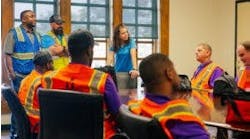The Transportation Research Board (TRB) of The National Academies of Sciences, Engineering, and Medicine released Fast-Tracked: A Tactical Transit Study on Sept. 11, which examines transit projects that use low-cost materials and accelerated timelines to expand transit.
The report, authored by Miami-based urban planning firm Street Plans, shows how transit agencies and other entities are using innovative methods to improve transit speed, access and ridership at a fraction of both the cost and time of conventional projects. TRB explains this is a first of its kind study that focuses on how North American cities are increasingly turning to the quick-build methodology to expand transit options, improve existing service and increase ridership.
“Typical transit projects can cost millions of dollars and take decades to come to fruition,” said principal researcher Tony Garcia. “With a quick-build approach to transit you can deliver transit service immediately, while longer term planning takes place. For many of these projects, if the pilot had not been implemented, city residents might still be waiting for these improvements to take place.”
Garcia noted that among the pilot projects studied in the report, 77 percent were delivered or are planned to be made permanent.
The report details 20 bus and streetcar “Tactical Transit” projects that showed improvements to speed, access, ridership and rider experience. TRB says tactical transit projects are those that are implemented within one to two years of inception, and cost under $200-300,000. Projects were divided into three categories based on their intended outcome: speed and reliability, access and safety, and rider experience. Among the most notable findings were:
- 6.7 miles of new, dedicated bus lanes piloted, with an average project timeline (conception to implementation) of 11 months.
- Projects in the Speed + Reliability category saw transit travel time savings from 20 percent to 50 percent, with the most common savings being 20 percent to 30 percent.
- Projects in the Access + Safety category showed increases in ridership of up to 17 percent.
TRB notes that whether it’s transporting commuters faster from A to B, reconfiguring a roadway to increase safety for all users, or making simple improvements to provide a more comfortable ride, these projects produced positive results in the short-term, while longer-term planning continues.
The report is available for download here.


